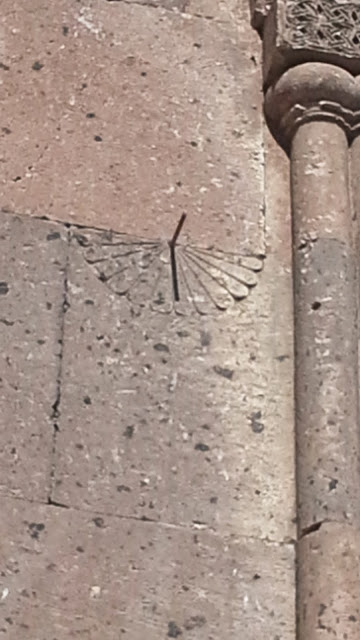We breakfasted well and met the minibus at 8.30. On board were Celhil, Stanley, the Swiss couple, Juan (an American, whose wife was sick) and the driver. We started off on the 45 kms to Ani. On the way Celhil gave a synopsis of the extremely complex history of the area. The tensions and territorial disputes go on till the present day. According to Celhil the Russians are the villains of the piece, but the Turks would say that wouldn't they. Certainty there are still existing and long running internecine disputes but the Russians are stirring things up. Indeed it's the Russian troops that police the Armenian border but then NATO troops are bunkered up facing them, half a kilometre away.
The minibus was called back after 10 kms so they could swap it for a smaller one. The replacement looked like it had been in a war scene with a totally shattered windscreen. No, not bullets but projectile stones from the recently resurfaced road.
Ani was the main reason we came to Kars. A UNESCO world heritage site. It was the ancient Armenian state capital. Strategically situated on a bulge in the river Alaca canyon. It was a nexus point on the silk and spice road. Anyone travelling either direction East West would have to encounter it.Likewise anyone coming from the North between the Black Sea and the Caspian Sea. Not surprisingly Ani was invaded many times from all directions over the thousand years or so that it flourished. It is now a huge deserted city that once had a population of over 100,000. It was called the city of a thousand churches. It is more the atmosphere of what was, than the existing buildings that impresses. Also the setting, the feeling of being alone in the high steppe,with only the wind and grass for company.
A little history next: Ani was selected by the Bagratid King Ashot 3 to be his new capital in 961 (he moved from Kars). The Byzantines took over in 1045 then the Seljuks from Persia gained it. Next the Kingdom of Georgia marched in. The struggles went on until the Moguls arrived in 1239. These nomads had little time for city life and didn't bother much when the great earthquake toppled much of Ani in 1319. Tamberlane's depredations were the last blow and trade routes shifted consigning Ani to the dustbin of history.
How about a look around?
This is the entrance gate. From here we worked our way clockwise round the site. We were given 3 hours but you really need 4 as a minimum.

The church of The Redeemer built to house a portion or the True Cross in 1034
The church of St Gregory which has superb surviving frescoes and external decoration including a tiny sundial. Can you tell the local time? Built in 1215
This is the Convent of the Virgins. You need to expand the picture to see it properly. You can't get any nearer because it's off limits. You should also be able to see the ruins of the old silk road bridge.
Not a pumping station but the Menucer Camii ( Mosque ) the first mosque built by the Seljuks after they conquered in 1072
This is the view from the inside of the mosque looking back at the Convent and bridge.
Helen in the foreground with Ic Kale ( the keep ) in the background. This is also off limits.
The Church of St Gregory which dates from the late 900s.
Look across the river to the Armenian side and notice the rock-cut village
Kervansaray (the Church of the Holy Apostles) built in 1031, the Seljuks used it as a caravanserai hence the name.
The detail in this ruined church is still stunning created by polychromatic stone inlay.
This is the Church of St Gagic built in 998 by the same architect who designed the Cathedral. It's ambitious dome collapsed shortly after it was finished.
The Seljuks Palace, entrance tower. Note the a symbol, the use of which became much perverted in the 20th century.
I had spent a lot of time reading and researching this place. My conclusion? The site far outweighed my high expectations. If you are ever hereabouts don't dare miss it. One of the most memorable days of my life.
















http://en.m.wikipedia.org/wiki/Ani
ReplyDeleteVery impressive. Enjoying your blog. M and K
ReplyDelete